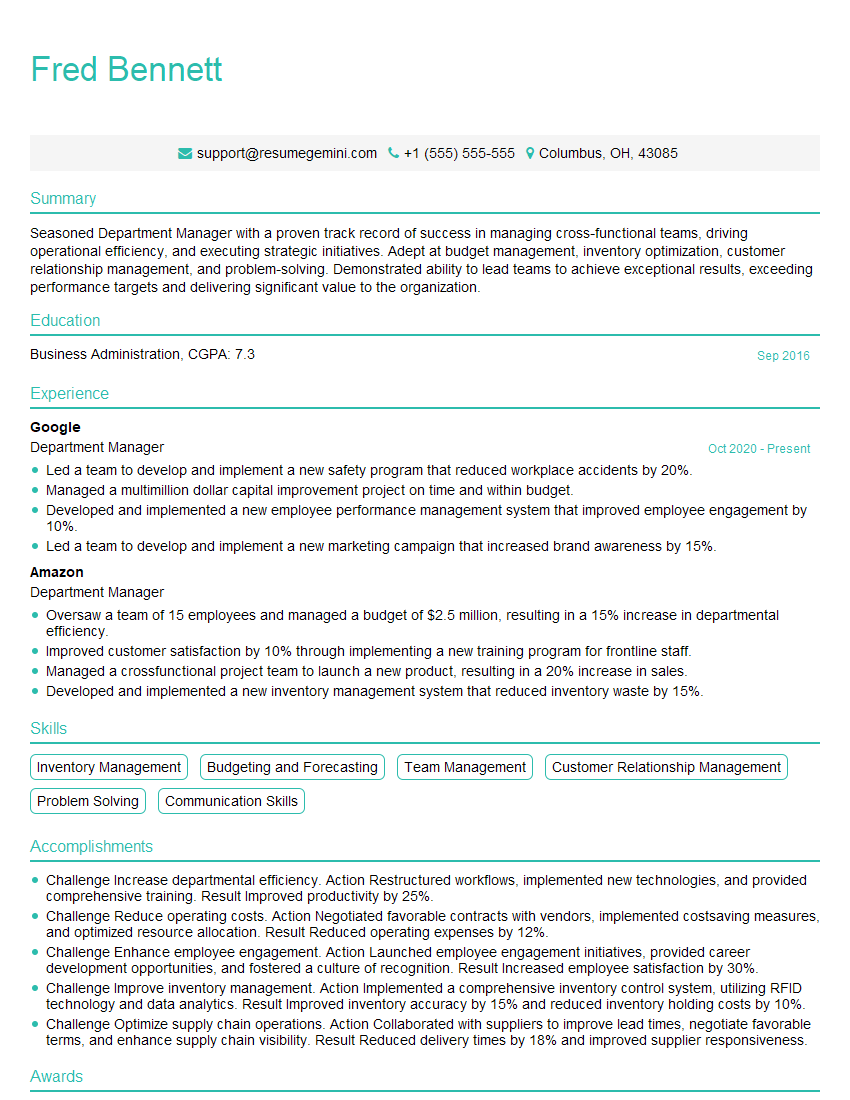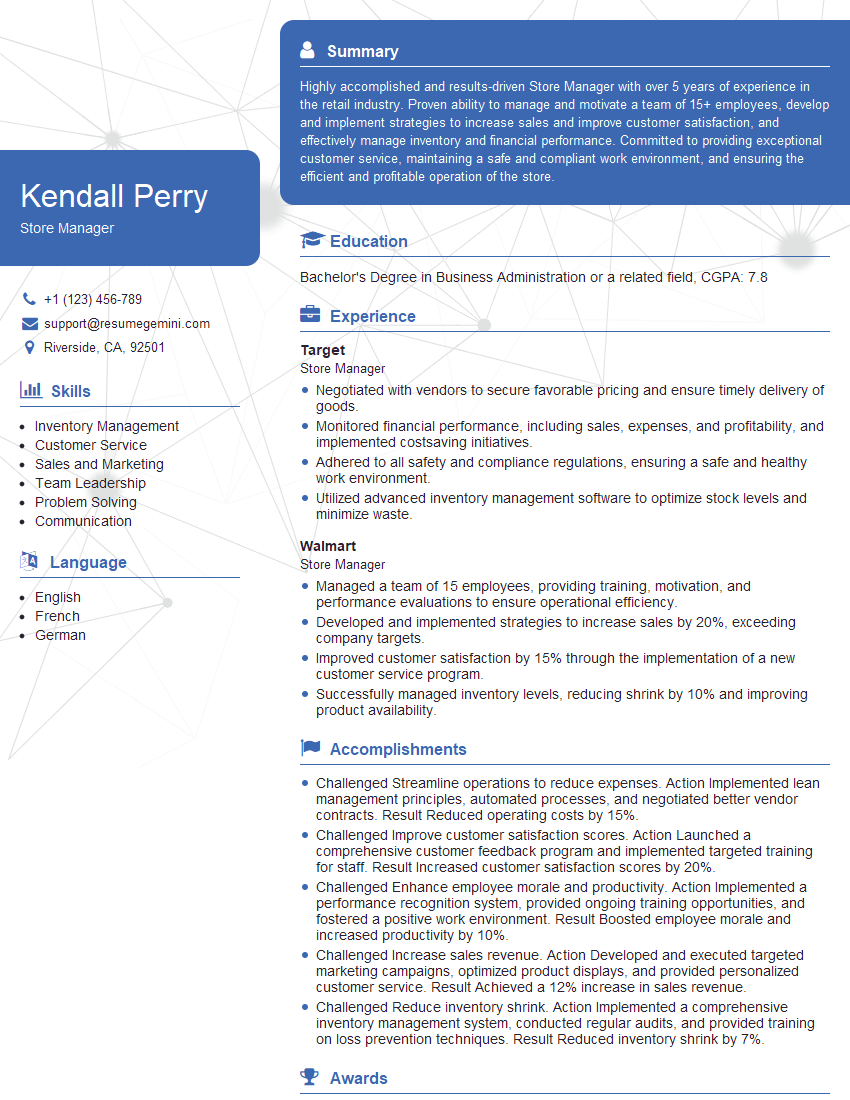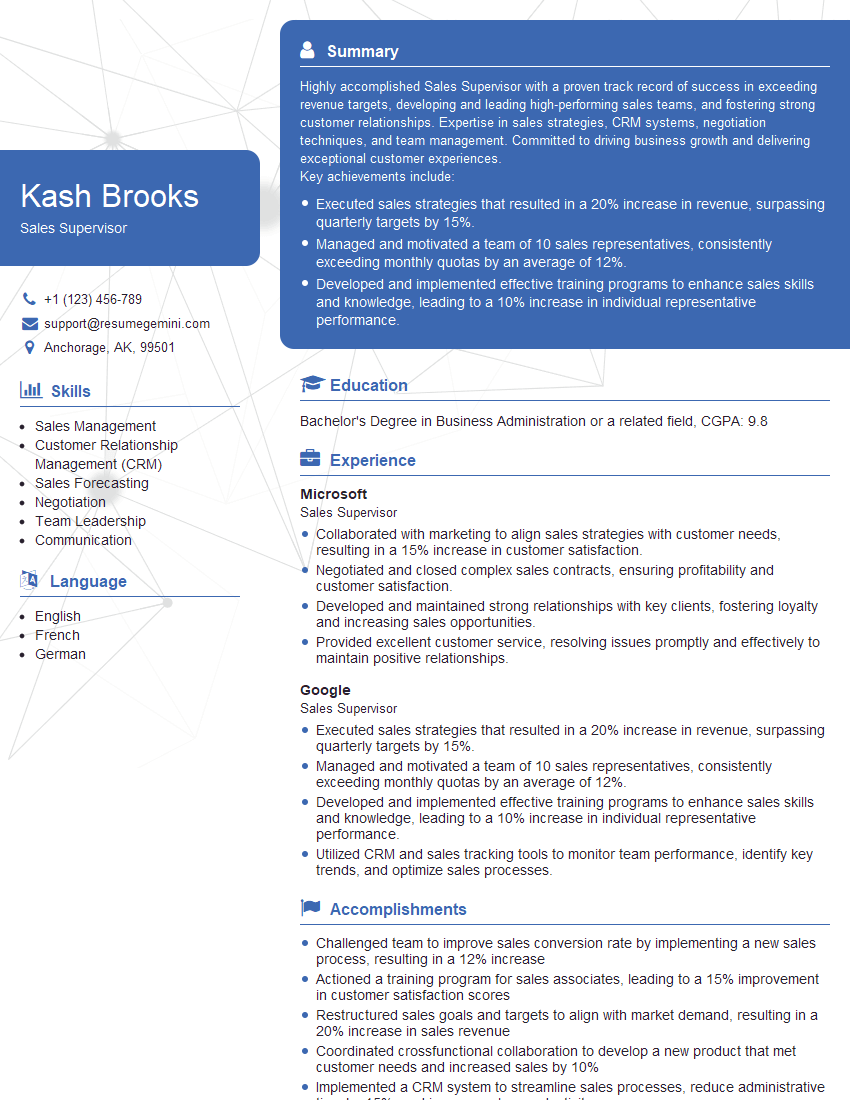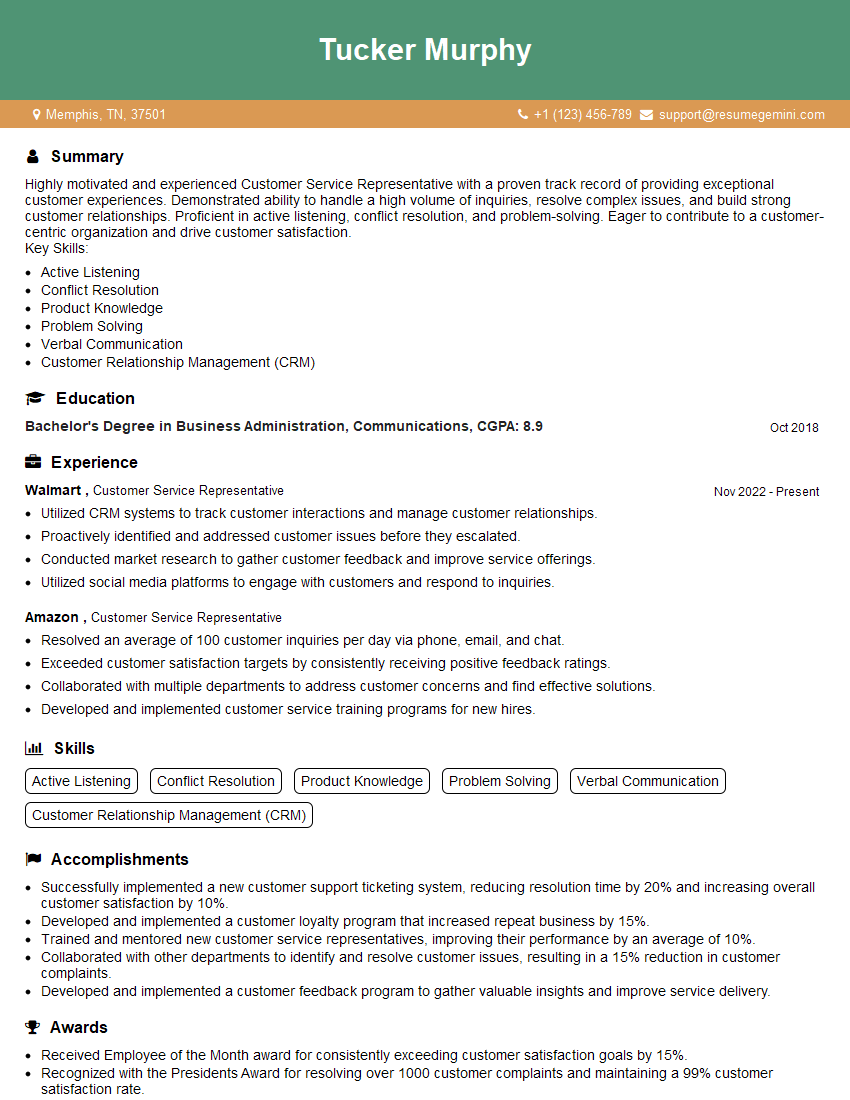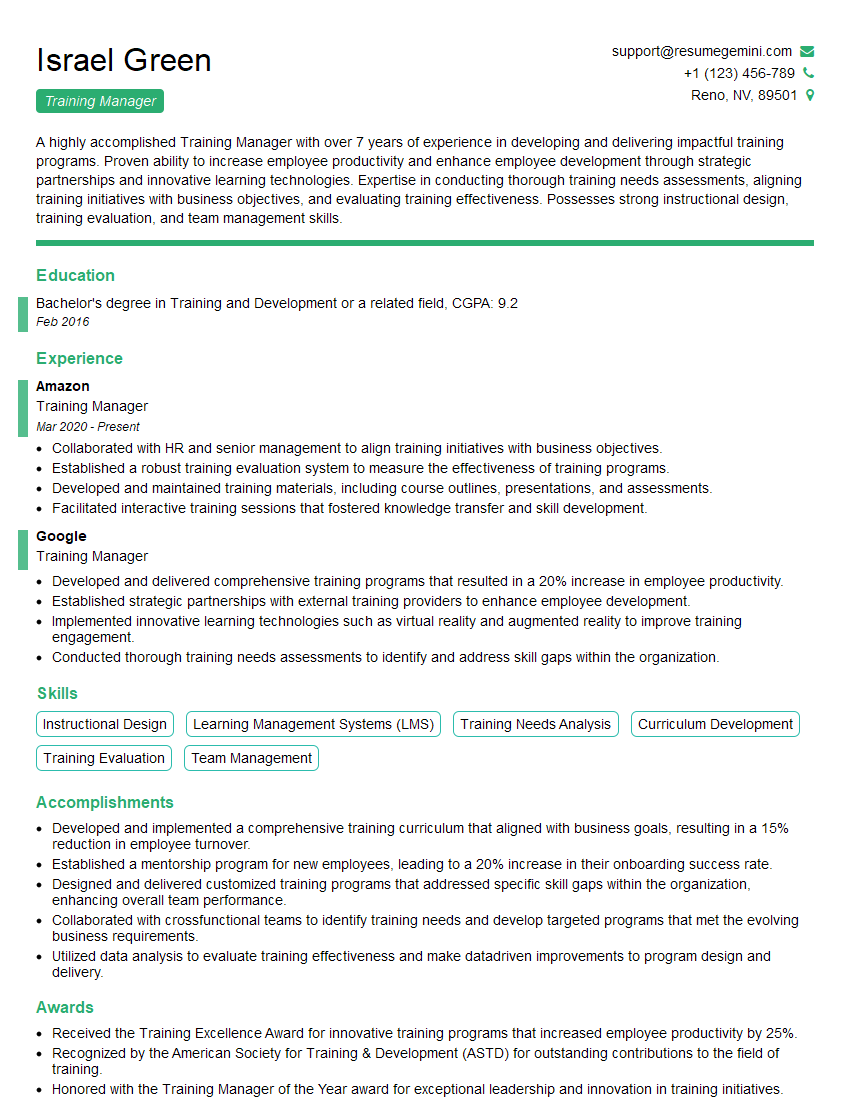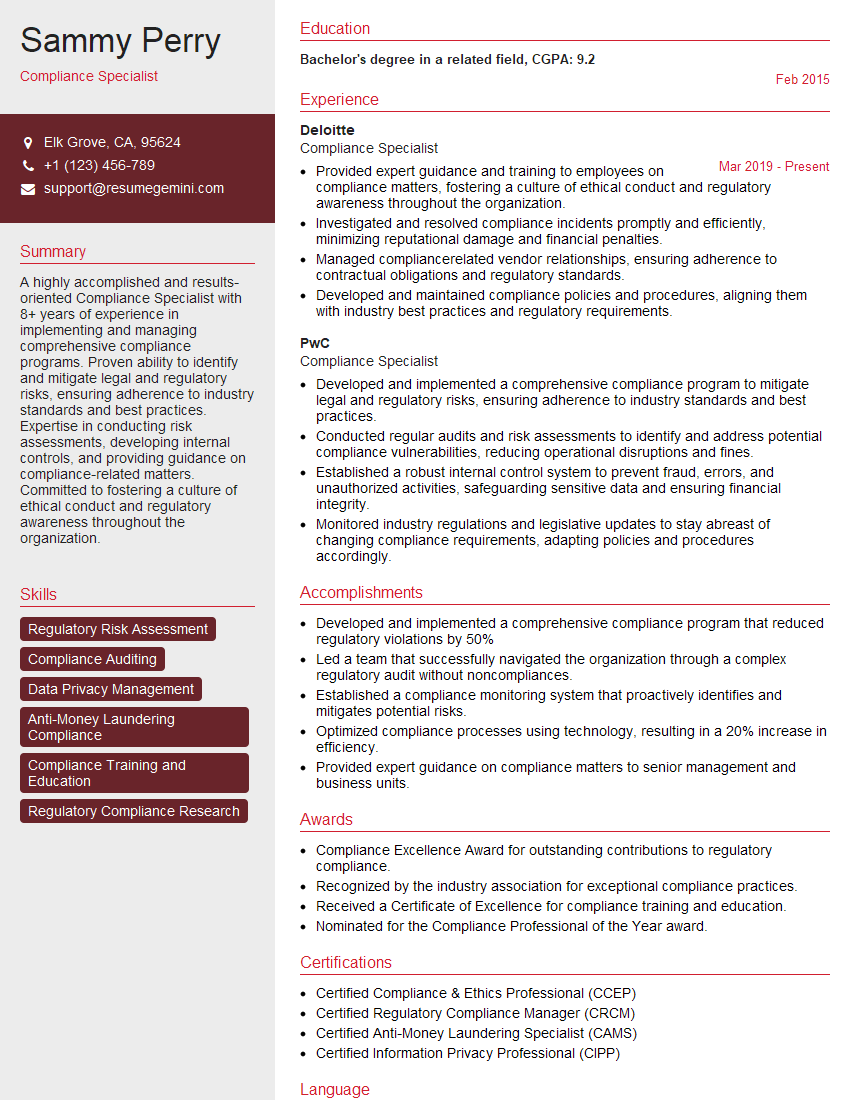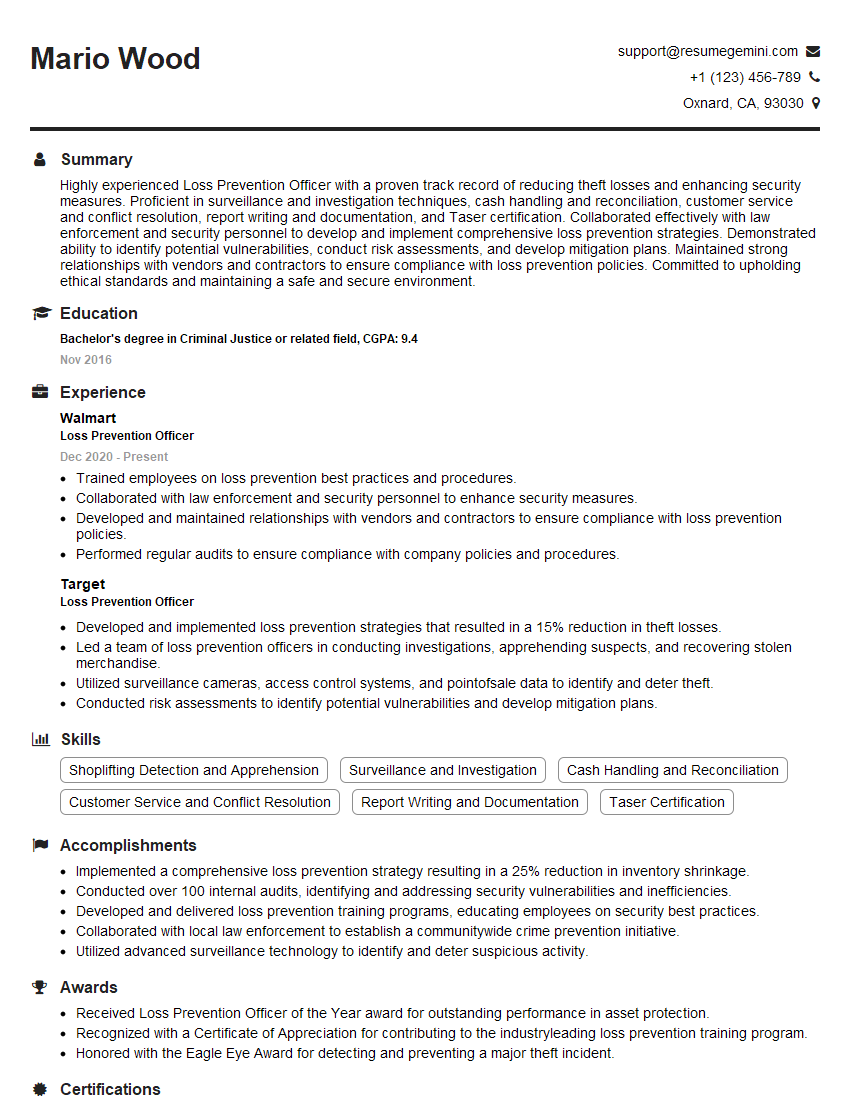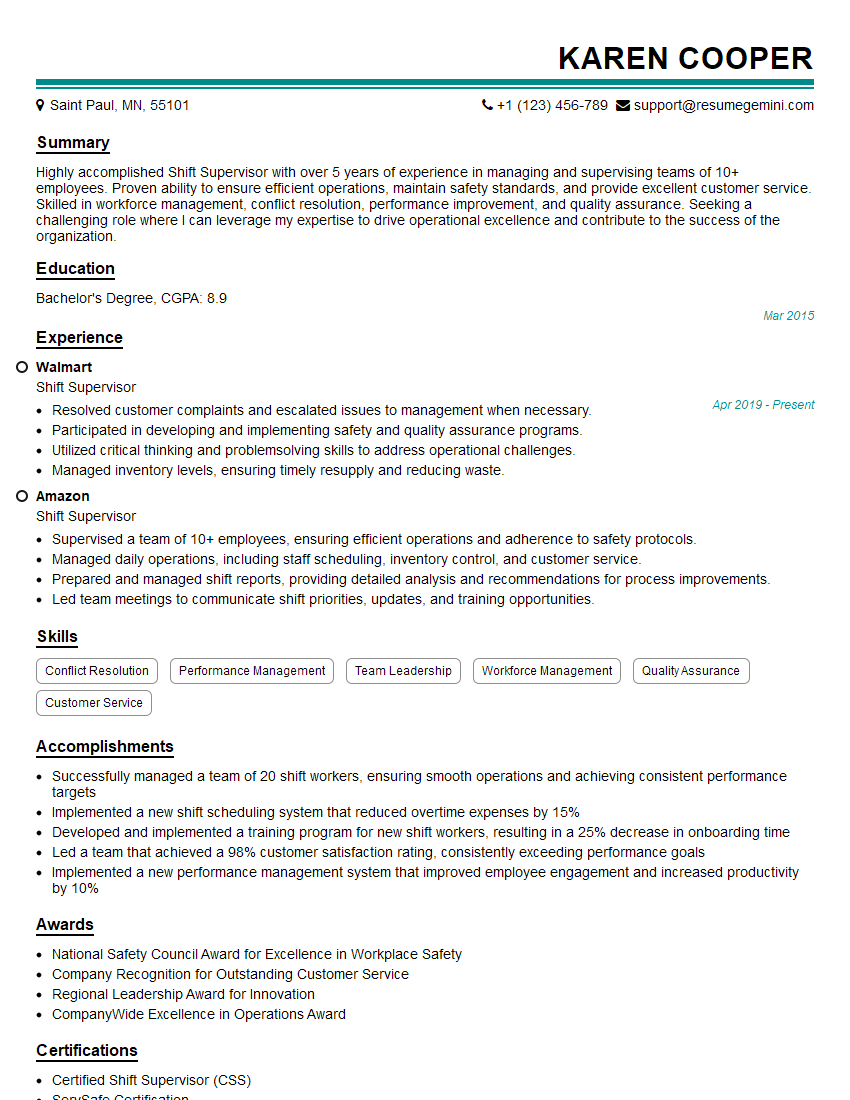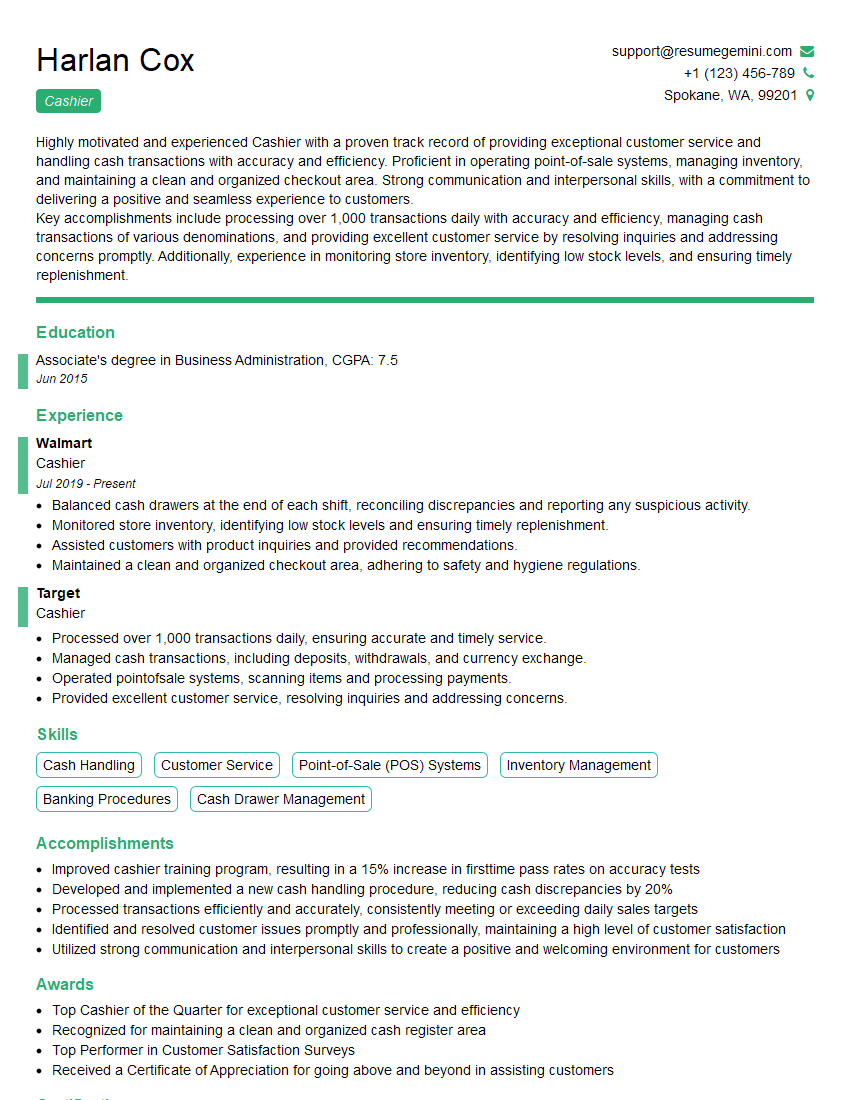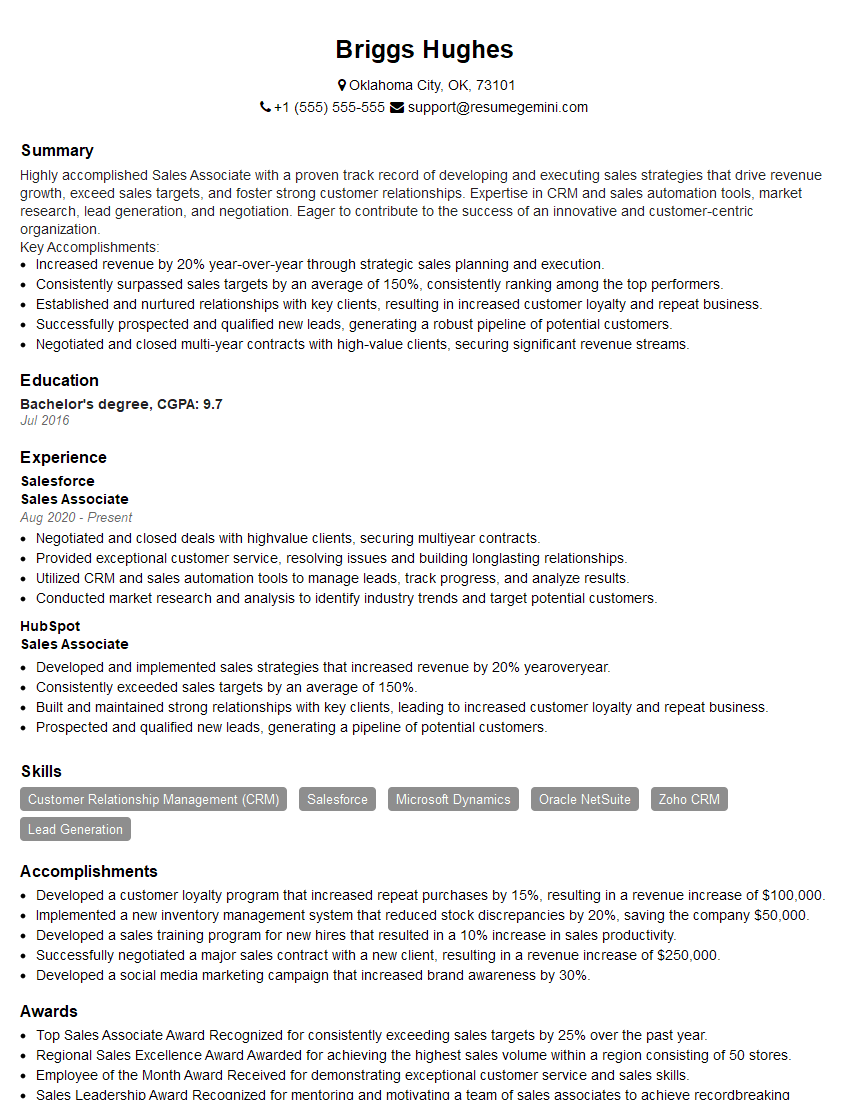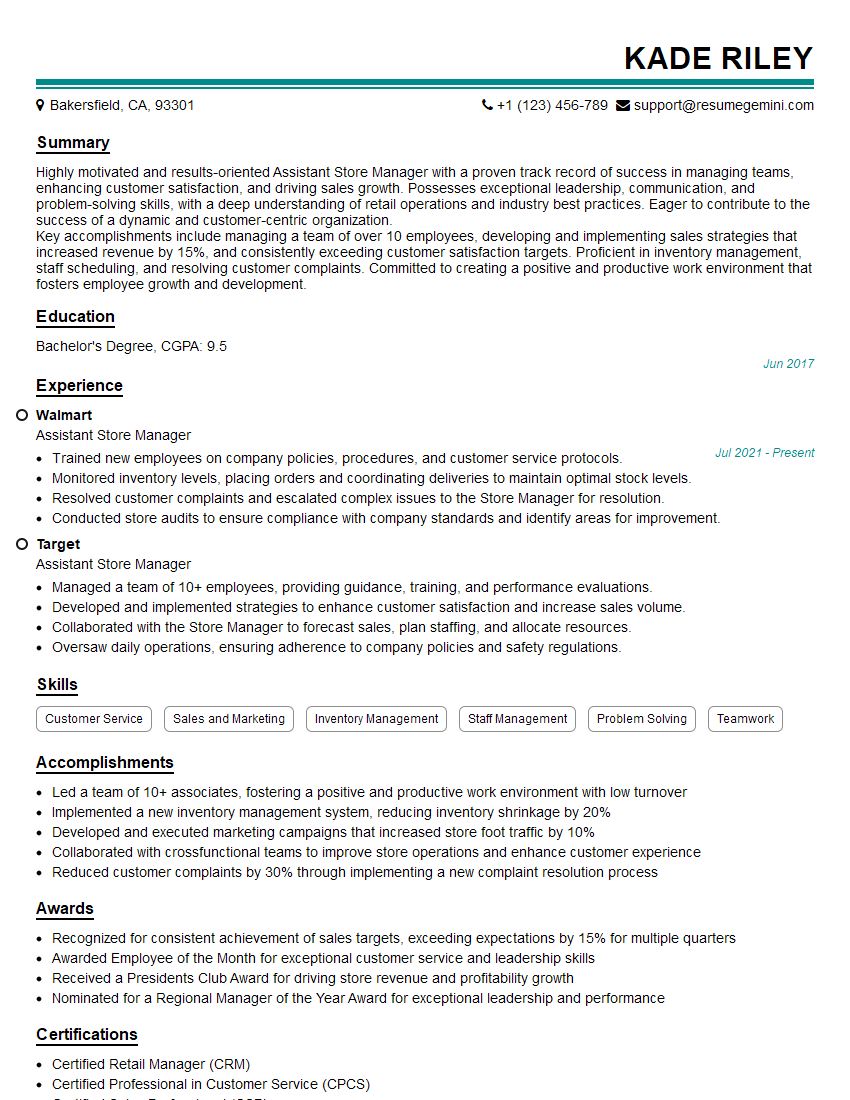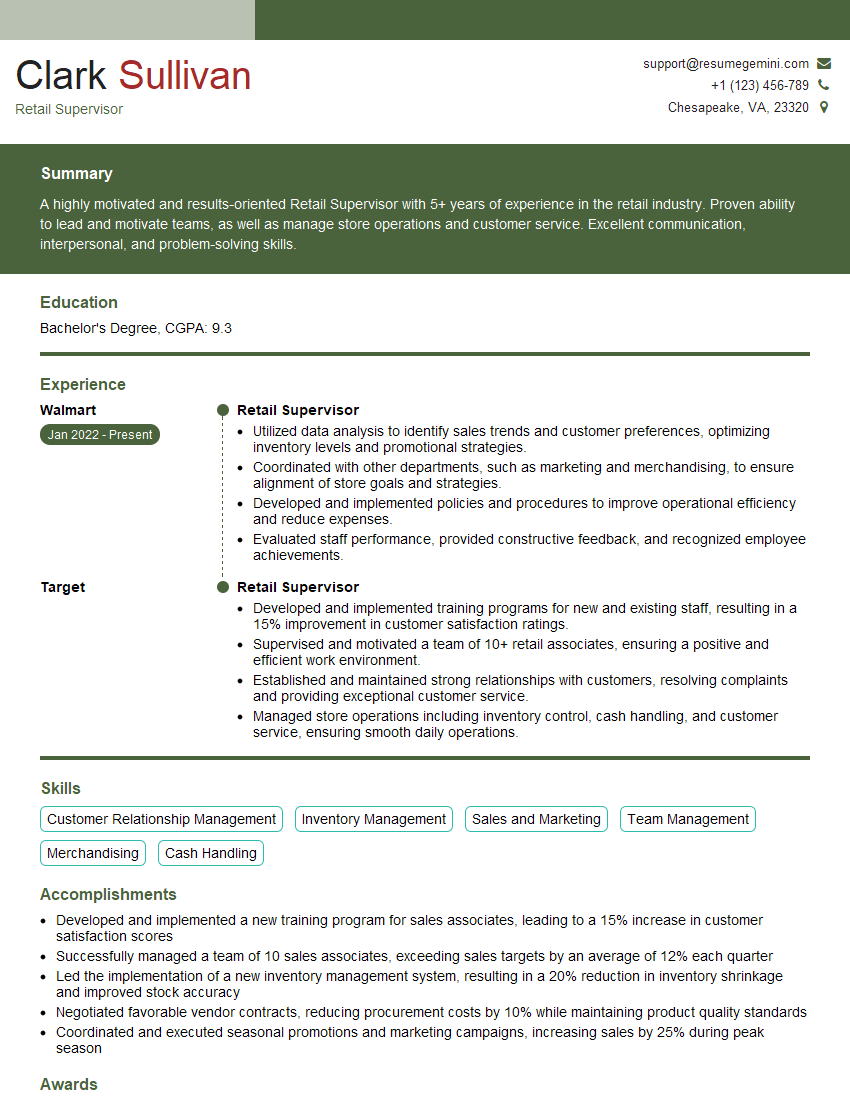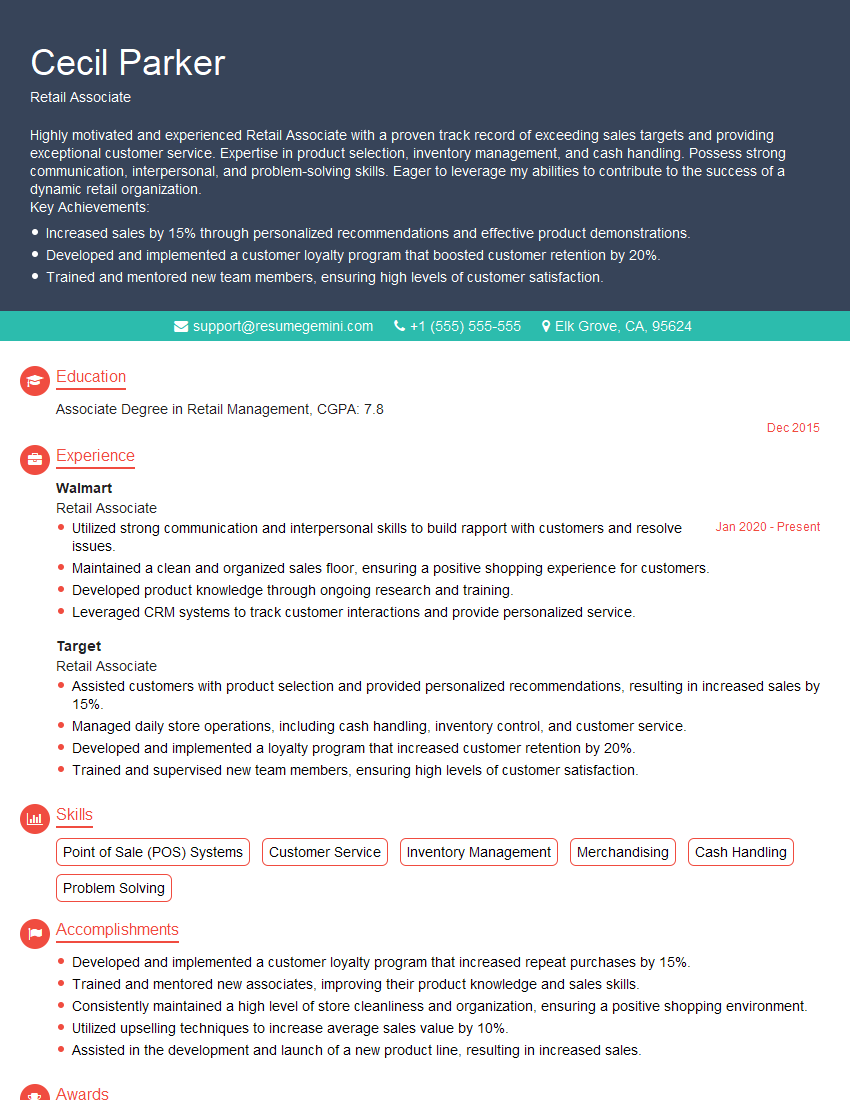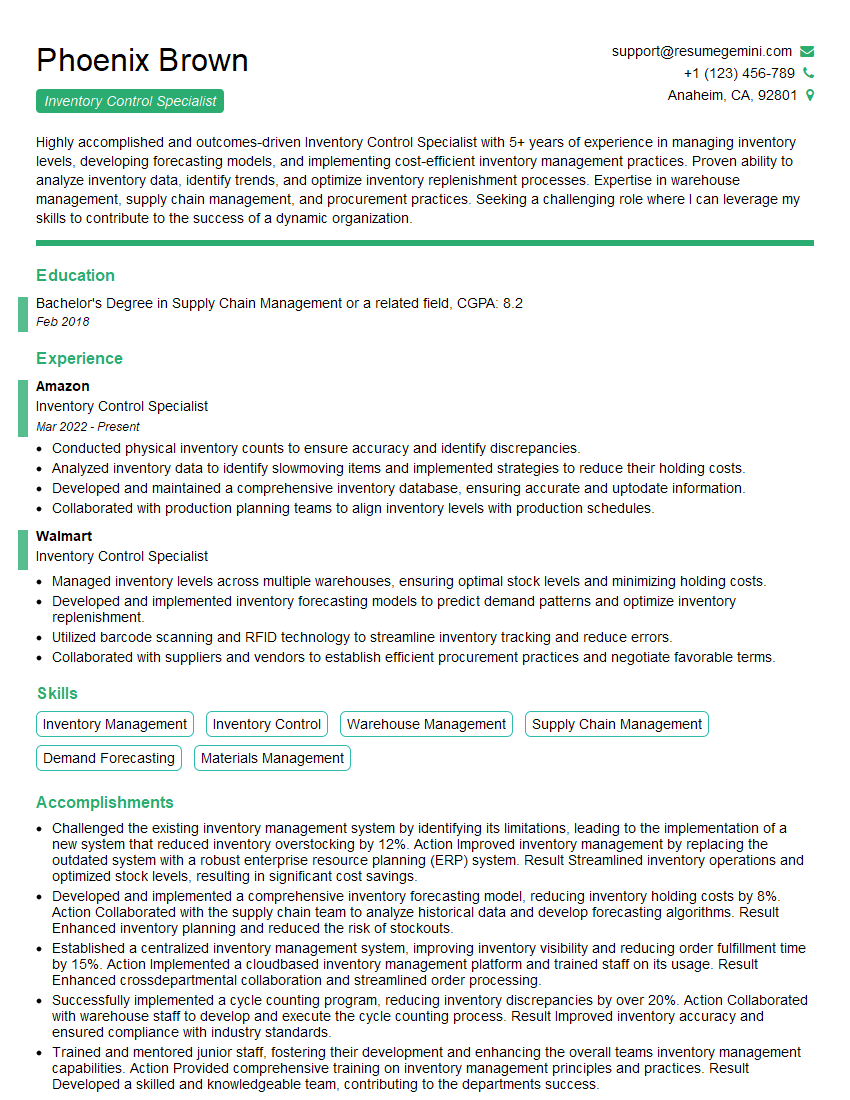Preparation is the key to success in any interview. In this post, we’ll explore crucial Knowledge of Store Policies and Procedures interview questions and equip you with strategies to craft impactful answers. Whether you’re a beginner or a pro, these tips will elevate your preparation.
Questions Asked in Knowledge of Store Policies and Procedures Interview
Q 1. What are the store’s policies regarding employee discounts?
Our employee discount policy is designed to show appreciation for our dedicated team. Eligible employees receive a 20% discount on most merchandise, excluding sale items and certain electronics. The discount is applied at the checkout using a unique employee ID. We regularly review and update this policy to ensure fairness and alignment with company objectives. For instance, seasonal variations in discount rates might be considered during periods of high sales volume. This discount is a privilege, not a right, and is subject to review based on individual performance and adherence to company policies.
Q 2. Describe the procedure for handling customer returns.
Handling customer returns is a crucial aspect of excellent customer service. Our policy centers around providing a hassle-free experience. Customers have 30 days from the purchase date to return unworn, undamaged merchandise with the original receipt for a full refund or exchange. Items without a receipt are eligible for store credit based on the current price. For damaged or defective goods, we offer a full refund or replacement, regardless of the return timeframe. We use a standardized return form to track all transactions and ensure consistency across all locations. For example, if a customer returns a dress that’s clearly been worn or damaged beyond the scope of acceptable use, we will explain our policy and offer alternative solutions if possible. This standardized approach simplifies the process and prevents disputes.
Q 3. How do you handle a situation where a customer is unsatisfied with a purchase?
Customer satisfaction is paramount. When a customer expresses dissatisfaction, our first step is to actively listen and understand their concerns. Empathy is key; we aim to make them feel heard and valued. Depending on the issue, solutions may range from offering an exchange or refund to providing a discount on a future purchase. In some cases, we may involve a manager to escalate the issue and find a suitable resolution. For example, if a customer is unhappy with the color of a purchased item and we have the alternate color in stock, offering an immediate exchange will often solve the problem. If the item is discontinued, we’ll explore alternatives, like a store credit or a partial refund.
Q 4. Explain the store’s policy on handling damaged merchandise.
Damaged merchandise is handled according to its cause and extent. Damage occurring during shipment is dealt with by contacting the shipping carrier and initiating a claim. Internal damage (e.g., from improper handling in the store) requires immediate reporting to a supervisor. Slightly damaged items may be discounted and sold, while severely damaged items are typically discarded in accordance with safety and waste disposal regulations. Each case is documented, and we continuously review our handling procedures to minimize instances of damage. For example, a damaged box might only result in a price reduction if the product itself is untouched, whilst severe damage would require the product to be removed from sale.
Q 5. What is the store’s protocol for opening and closing procedures?
Opening and closing procedures are meticulously documented and followed to ensure the safety and security of our store and employees. Opening procedures include checking the security system, counting the till, preparing the sales floor, and checking all equipment is functioning. Closing procedures involve securing all cash, balancing tills, locking up displays, and setting the alarm system. We also maintain a detailed checklist to ensure all steps are consistently completed by all staff. For example, failure to properly secure the premises could result in security breaches, and a failure to count the till could result in accounting inaccuracies.
Q 6. How do you ensure compliance with health and safety regulations?
Ensuring compliance with health and safety regulations is an ongoing priority. We adhere to all relevant local and national codes, providing regular staff training on safety protocols, emergency procedures, and the proper use of equipment. We conduct regular inspections of the store to identify and rectify potential hazards, and maintain detailed records of all safety-related incidents. Compliance training is mandatory, and updated certifications are tracked to guarantee our workforce is appropriately qualified. For example, we ensure appropriate fire safety equipment is readily available and accessible, and all staff undergo mandatory fire safety training. Regular cleaning protocols minimize hygiene risks.
Q 7. What is the process for reporting a safety hazard?
Reporting a safety hazard is straightforward. Employees are encouraged to report any potential safety concerns immediately to their supervisor or manager. This can be done verbally or using a designated reporting form. The report should include a clear description of the hazard, its location, and any potential risks. Once reported, the hazard is assessed, and appropriate corrective actions are taken, ranging from immediate remediation to involving external specialists. All reports are logged and reviewed regularly to identify trends and implement preventative measures. For example, a broken shelf needs to be reported and the area cordoned off until a repair crew fixes it, preventing customer injuries.
Q 8. How do you manage inventory discrepancies?
Managing inventory discrepancies is crucial for maintaining accurate stock levels and preventing financial losses. It involves a multi-step process beginning with regular cycle counts, where a subset of inventory is physically counted and compared to the system’s record. Discrepancies are investigated to determine the root cause – whether it’s data entry errors, theft, damage, or simply inaccurate initial counts.
- Data Entry Errors: These are corrected immediately, updating the system with the accurate count.
- Theft/Damage: These require thorough investigation, potentially involving security footage review and employee interviews, followed by appropriate disciplinary action if necessary. A report may need to be filed.
- Inaccurate Initial Counts: These highlight the need for improved counting procedures and better staff training. We may implement double-checking mechanisms or utilize barcode scanners for increased accuracy.
Regular reconciliation of physical counts with the inventory management system is key. We use a software system that generates reports highlighting significant discrepancies, allowing for prompt investigation and resolution. Think of it like balancing your checkbook – you wouldn’t let small differences accumulate without addressing them.
Q 9. Describe the process for dealing with shoplifting or theft.
Dealing with shoplifting or theft requires a calm and measured approach, prioritizing the safety of both staff and customers. Our policy emphasizes de-escalation and observation, rather than confrontation. If shoplifting is suspected, we discreetly observe the individual.
- Observation: We avoid direct accusations; instead, we carefully observe the individual’s behavior.
- Evidence Gathering: If evidence of theft is clear (e.g., concealed merchandise), we follow our established procedure, which may include discreetly alerting security or management.
- Legal Action: Depending on the value of stolen goods and the store’s policy, we may choose to involve law enforcement. We fully cooperate with the authorities and provide any necessary evidence.
- Prevention: We emphasize loss prevention strategies such as visible security cameras, strategically placed mirrors, and employee training on identifying suspicious behavior. It’s about proactive prevention as much as reactive response.
The safety of our staff is paramount. We never put employees in harm’s way; our priority is always to ensure their well-being.
Q 10. What is the store’s policy on cash handling and reconciliation?
Our cash handling policy is stringent and designed to prevent errors and losses. It involves a robust system of checks and balances.
- Opening/Closing Procedures: Each shift begins and ends with a detailed cash count, recorded and verified by two team members. This ensures accuracy and identifies discrepancies early on.
- Transaction Recording: Every transaction is carefully documented via our POS (Point of Sale) system, providing a detailed audit trail for all financial activity. This digital record allows us to track down errors effectively.
- Regular Reconciliation: Daily cash counts are reconciled with the POS system’s records at the end of each business day. Any discrepancies are immediately investigated and documented.
- Security Measures: We utilize secure cash registers and safes, and access is limited to authorized personnel. Regular security audits help to identify any vulnerabilities in our cash handling processes.
Think of it like a secure bank vault – multiple layers of security and monitoring ensure the protection of assets. Our system isn’t just about catching errors; it’s about preventing them from happening in the first place.
Q 11. How do you handle customer complaints regarding store policies?
Handling customer complaints about store policies requires empathy, professionalism, and a commitment to finding a fair resolution. Our approach emphasizes active listening and understanding the customer’s perspective.
- Active Listening: We listen carefully to the customer’s complaint without interruption, ensuring they feel heard and understood.
- Policy Explanation: We clearly explain the relevant store policy, providing specific examples to clarify any ambiguities.
- Finding a Solution: Depending on the nature of the complaint, we may offer a compromise, a refund, an exchange, or other appropriate resolution within the bounds of our policies and procedures.
- Escalation: If a resolution can’t be reached at the store level, we escalate the complaint to management for further review.
Customer satisfaction is paramount, and even if we can’t always grant the customer’s exact request, we aim to leave them feeling heard and valued. The goal is to transform a negative experience into an opportunity for improvement.
Q 12. Explain the procedure for processing a customer order.
Processing a customer order involves a series of steps designed to ensure accuracy and efficiency. The process varies slightly depending on whether the order is in-store or online, but the core principles remain consistent.
- Order Placement: The customer places an order, either in-person, by phone, or online.
- Order Verification: The order is verified for accuracy and availability of stock. If an item is out of stock, the customer is notified, and alternatives may be offered.
- Payment Processing: Payment is processed securely using the customer’s preferred method (cash, card, etc.).
- Order Fulfillment: The order is fulfilled – whether that means handing the customer their purchase directly or preparing it for shipping (in case of online orders).
- Order Confirmation: The customer receives confirmation of their order, along with details such as tracking numbers (if applicable).
The entire process is designed to be streamlined and straightforward for both the customer and our staff, focusing on a positive customer experience.
Q 13. How do you ensure that all employees are aware of and follow store policies?
Ensuring all employees are aware of and follow store policies requires a multifaceted approach combining training, communication, and consistent reinforcement.
- Initial Training: Comprehensive training on all store policies is provided to new employees during onboarding.
- Ongoing Training: Regular refresher courses and updates are implemented to keep staff informed about policy changes and best practices.
- Policy Manuals: Easily accessible and well-organized policy manuals are provided to every employee.
- Regular Communication: Consistent communication through staff meetings, email updates, and posted notices helps reinforce policy adherence.
- Performance Management: Regular performance reviews include an assessment of policy compliance, and disciplinary action is taken where necessary.
Think of it as a continuous learning process – we are constantly educating and reminding our employees of the importance of following established policies and procedures. Consistent reinforcement is key for ensuring compliance.
Q 14. What is your understanding of the company’s code of conduct?
The company’s code of conduct outlines the ethical standards and principles that guide employee behavior. It emphasizes integrity, honesty, respect, and professionalism in all interactions. The code encompasses various areas, including:
- Ethical Conduct: Maintaining high ethical standards in all business dealings, avoiding conflicts of interest, and reporting any unethical behavior.
- Customer Relations: Treating customers with respect and courtesy, providing excellent service, and resolving customer issues fairly.
- Compliance: Adhering to all relevant laws, regulations, and company policies.
- Workplace Conduct: Maintaining a respectful and professional work environment, free from harassment or discrimination.
- Data Privacy: Protecting customer data and respecting privacy rights.
The code of conduct isn’t just a document; it’s a living guide that shapes our daily actions and interactions. It ensures that we operate with integrity and uphold the company’s values in everything we do.
Q 15. How do you manage employee timekeeping and attendance according to store policy?
Employee timekeeping and attendance are managed through a combination of our company’s timekeeping system and adherence to clearly defined store policies. We utilize a biometric clock-in/clock-out system, ensuring accurate recording of hours worked. Employees are required to clock in at the start of their shift and clock out at the end. Any discrepancies, such as late arrivals or early departures, are documented and addressed according to our attendance policy. This policy outlines acceptable reasons for tardiness and absenteeism, alongside the consequences of repeated violations. For instance, three instances of unexcused tardiness within a month could result in a verbal warning, escalating to written warnings and potential disciplinary action if the pattern continues.
Supervisors conduct regular reviews of time records to identify any irregularities or potential issues. We also utilize reporting functionalities within the timekeeping system to track employee attendance patterns, identify trends, and proactively address potential problems. For example, if an employee consistently arrives late on Mondays, we’d investigate possible reasons and work with them to find a solution, perhaps adjusting their schedule or exploring logistical challenges.
Career Expert Tips:
- Ace those interviews! Prepare effectively by reviewing the Top 50 Most Common Interview Questions on ResumeGemini.
- Navigate your job search with confidence! Explore a wide range of Career Tips on ResumeGemini. Learn about common challenges and recommendations to overcome them.
- Craft the perfect resume! Master the Art of Resume Writing with ResumeGemini’s guide. Showcase your unique qualifications and achievements effectively.
- Don’t miss out on holiday savings! Build your dream resume with ResumeGemini’s ATS optimized templates.
Q 16. What are the steps involved in handling a customer dispute?
Handling customer disputes requires a calm, empathetic, and solution-oriented approach. Our first step involves actively listening to the customer’s complaint, ensuring they feel heard and understood. We aim to identify the root cause of their dissatisfaction, whether it’s a damaged product, a billing error, or poor service. We then explain our store policies relevant to the situation, clearly and concisely. Depending on the nature of the complaint, we may offer several solutions such as a refund, exchange, repair, or a discount. We document all aspects of the interaction, including the customer’s complaint, the steps taken to resolve it, and the final outcome. This documentation helps us to track trends and improve our customer service procedures.
For example, if a customer returns a damaged item, we’d inspect the product, review the purchase receipt, and, if valid, process a refund or exchange according to our return policy. However, if the damage was caused by misuse, we’d explain the policy and explore alternative solutions. If a resolution cannot be reached immediately, we offer to escalate the issue to a manager or supervisor.
Q 17. Describe the store’s policy on handling lost and found items.
Our lost and found policy prioritizes honesty and fairness. All found items are documented, including a description, date found, and the location where it was discovered. These items are stored in a secure location for a designated period (usually 30 days). Customers can inquire about lost items by providing a description of the item. We encourage them to check our lost and found regularly and check with management if the item isn’t found. If an item is of significant value, we take additional steps to try and identify the owner, such as checking for identifying information or contacting law enforcement if necessary.
After the 30-day period, unclaimed items are either donated to a local charity, disposed of properly, or, if appropriate, held for an extended period depending on its value or potential to identify the owner. We maintain a log of all lost and found items and their disposition, which assists in managing our inventory and ensuring accountability.
Q 18. How do you address situations involving customer conflict or aggression?
Addressing customer conflict or aggression requires prioritizing safety and de-escalation. Our primary goal is to ensure the safety of both the customer and our employees. We’re trained to remain calm and professional, using active listening techniques to understand the customer’s perspective, even if they’re expressing their frustration aggressively. We avoid escalating the situation by matching their tone or behavior. We offer apologies where appropriate, demonstrating empathy and understanding, even if we don’t agree with their viewpoint.
If the situation becomes unmanageable, we call for assistance from other staff members, security personnel, or law enforcement, depending on the severity of the situation. We maintain a safe distance and avoid physical confrontation at all costs. After the incident, we thoroughly document the event, including the customer’s behavior, the steps taken to resolve the situation, and any follow-up actions. This documentation helps prevent future similar situations.
Q 19. Explain the process for dealing with a customer who refuses to comply with store rules.
When a customer refuses to comply with store rules, we reiterate the specific rule and its rationale calmly and respectfully. We explain the consequences of non-compliance, which may include being asked to leave the premises. Our approach is firm but fair, focusing on de-escalation. We never use threatening language or gestures. If the customer continues to refuse to comply, we inform them that we will need to ask them to leave. If they remain uncooperative, we may involve security or law enforcement. If a customer’s behavior is disruptive or threatening, we prioritise the safety of our staff and other shoppers. We have a clear protocol for dealing with such situations, always prioritizing de-escalation before taking more forceful action.
For example, if a customer refuses to wear a face mask during a mandate, we’d politely remind them of the policy, highlighting the safety of other customers and staff. If they are still unwilling to comply, we would politely inform them that they will not be permitted to remain in the store.
Q 20. How do you handle a situation where a policy is unclear or ambiguous?
When a policy is unclear or ambiguous, our first step involves seeking clarification from a supervisor or manager. We have established procedures to address policy ambiguities. We use internal communication channels, such as emails or team meetings, to address these issues and seek clarification in a timely manner. We always ensure policies are communicated effectively to all staff members, through training sessions, employee manuals and regular updates. In the meantime, we exercise our best judgment, ensuring we remain consistent with the overall principles and objectives of the store’s policies while maintaining fairness and respect for customers. We prioritize transparency and ensure that customers are treated fairly and consistently, even when facing ambiguous situations.
For instance, if a return policy is unclear about the timeframe for returns, we’d seek clarification from management before processing a return request from a customer, ensuring consistent application of the policy across all transactions.
Q 21. What are the store’s policies on social media usage by employees?
Our social media policy for employees emphasizes responsible online conduct and protecting the store’s reputation. Employees are expected to maintain professionalism in their online interactions, particularly when posting content that may be associated with the store. We discourage employees from posting anything that could damage the company’s image, disclose confidential information, or violate company policies. The policy also outlines expectations regarding the use of company logos or trademarks in personal social media posts. While employees are generally free to express their personal views, they must ensure these do not conflict with company values or policies.
We provide training to employees on responsible social media use, highlighting potential pitfalls and best practices. We emphasize the importance of maintaining confidentiality and avoiding public criticism of the store or its policies. Any violation of the social media policy is addressed through established disciplinary procedures, ranging from verbal warnings to termination of employment, depending on the severity of the infraction.
Q 22. Describe the procedures for handling a security breach.
Handling a security breach involves a swift and systematic response to minimize damage and ensure the safety of our staff and customers. Our procedure is designed to address various scenarios, from shoplifting to more serious incidents like vandalism or data breaches.
- Immediate Action: The first step is to ensure the safety of everyone present. This might involve calling emergency services (911 or local equivalent) in case of injury or serious threats. If the situation is less severe, we contain the breach, preventing further loss or damage. For example, if it’s shoplifting, we observe the individual without confrontation (to avoid escalation) and note their description.
- Investigation: Once the immediate danger has passed, we initiate a thorough investigation. This involves reviewing security footage, gathering witness statements, and examining the scene for any evidence.
- Reporting: All security breaches are documented using a standardized incident report form. This report, along with any gathered evidence, is submitted to the store manager and, depending on the severity, to the corporate security team. If the incident involves a significant financial loss or a data breach, we follow specific regulatory protocols for reporting.
- Follow-up: Following the investigation, we implement corrective actions to prevent future incidents. This might involve upgrading security systems, improving staff training, or enhancing loss prevention measures. In case of a data breach, we take steps to notify customers as required by law.
Think of it like this: imagine a dam breach. First, you need to stop the flow of water. Then, you assess the damage, and finally, you work on fixing the dam to prevent future floods. Our security breach procedure mirrors this process, addressing immediate concerns before moving on to investigation and prevention.
Q 23. How do you ensure proper handling of confidential customer information?
Protecting customer confidential information is paramount. We employ several measures to ensure its proper handling, adhering to both internal policies and relevant data privacy laws (like GDPR or CCPA).
- Data Minimization: We only collect necessary customer information, avoiding unnecessary data collection.
- Access Control: Access to sensitive customer data is restricted to authorized personnel on a need-to-know basis. Passwords are regularly changed, and we employ strong access controls.
- Data Encryption: Sensitive data, both in transit and at rest, is encrypted to protect against unauthorized access. This means that even if someone were to gain access to our systems, they wouldn’t be able to easily decipher the data.
- Secure Disposal: When customer information is no longer needed, we use secure methods to dispose of it, either through shredding or secure electronic deletion.
- Employee Training: All employees receive regular training on data privacy and security best practices. We emphasize the importance of protecting customer data and outline the consequences of non-compliance.
For example, we use secure payment gateways for online transactions and never store full credit card numbers in our databases. We only store the last four digits for reference. This multi-layered approach is key to ensuring compliance and protecting our customers.
Q 24. How do you deal with a situation where a policy is potentially being violated by a coworker?
Witnessing a potential policy violation by a coworker requires a careful and measured approach. The goal is to address the issue while maintaining positive working relationships and fostering a culture of accountability.
- Observe and Document: First, I would carefully observe the situation to ensure I have accurate information. Documenting the incident with specific dates, times, and details is crucial.
- Informal Approach (if appropriate): If it’s a minor infraction and I have a comfortable relationship with the coworker, I may choose to address it informally. A friendly reminder of the policy and its importance might suffice.
- Formal Reporting: If the violation is serious or the informal approach doesn’t resolve the issue, I would report it to my supervisor or manager using the company’s designated channels. It is important to remain objective in reporting, focusing on the facts and avoiding personal opinions.
- Follow Company Procedures: I would follow the company’s established procedures for handling such situations. These often involve an investigation and potentially disciplinary action, as determined by management.
Think of it as a conflict resolution approach. You start with a less formal approach, escalating to a more formal one only if necessary. This prioritizes building a better environment, not just addressing the incident.
Q 25. Explain the store’s policy on employee breaks and meal periods.
Our store’s policy on employee breaks and meal periods is designed to ensure the well-being of our staff while maintaining operational efficiency. This policy adheres to all relevant labor laws.
All employees are entitled to scheduled breaks and meal periods based on their shift length. The precise details may vary depending on state and local regulations, but generally, employees working shifts longer than a certain duration are entitled to a paid lunch break and shorter, unpaid rest breaks throughout the workday. This information is outlined in our employee handbook. Employees are expected to take their scheduled breaks, and supervisors are responsible for ensuring that employees are not pressured to forgo their breaks. Any issues or exceptions should be discussed with the store manager. This ensures compliance with all applicable laws and respects our team’s health and wellness.
Q 26. How do you train new employees on store policies and procedures?
Training new employees on store policies and procedures is a crucial aspect of onboarding. We use a multi-faceted approach to ensure thorough understanding and compliance.
- New Hire Orientation: The initial orientation covers all major policies, including those related to security, customer service, safety, and handling confidential information. This is generally done with a presentation, interactive activities, and question-answer sessions.
- Policy Handbook Review: New employees receive a comprehensive employee handbook detailing all store policies. They are required to acknowledge their understanding by signing a receipt.
- On-the-Job Training: Experienced staff members mentor new hires, demonstrating procedures in a real-world setting and guiding them on how to handle various situations.
- Regular Refresher Training: To maintain compliance and enhance knowledge, we conduct regular refresher training sessions. These sessions cover updates to policies or changes in procedures.
- Quizzes and Assessments: To ensure knowledge retention, we administer quizzes or assessments to test the understanding of policies and procedures.
We believe that a well-trained workforce is a safe and productive workforce. By employing this comprehensive approach, we ensure our new employees are adequately prepared to perform their job duties while adhering to all policies and procedures.
Q 27. What are the store’s policies regarding accepting various forms of payment?
Our store accepts a variety of payment methods to cater to customer preferences and convenience. The specific types of payment accepted may vary slightly based on location, but generally include:
- Credit and Debit Cards: We accept all major credit and debit cards, ensuring secure processing through our point-of-sale (POS) system.
- Cash: We accept cash as a form of payment, with appropriate security measures in place for handling cash transactions.
- Gift Cards: We accept our own store gift cards as well as gift cards from select national brands.
- Mobile Payment Apps: We accept various popular mobile payment apps, such as Apple Pay, Google Pay, and Samsung Pay, enhancing customer convenience.
- Checks (with restrictions): We may accept checks, but there are often restrictions in place. For instance, the customer must have a local address and present identification. Personal checks are less frequently accepted compared to other payment methods.
All transactions are processed according to our strict procedures to prevent fraud and ensure accuracy. Employees receive thorough training on processing various payment methods securely and efficiently.
Q 28. How do you handle a situation where store equipment malfunctions?
Equipment malfunction is an unfortunate reality in any retail environment. Our procedure prioritizes safety and minimizes disruption to store operations.
- Safety First: The initial priority is to ensure the safety of staff and customers. If a malfunction poses a safety hazard (e.g., a malfunctioning refrigerator that creates a fire risk), we immediately shut down the equipment, evacuate the area if necessary, and contact emergency services.
- Assessment: Once the immediate safety concerns are addressed, we assess the nature and extent of the malfunction. We identify the specific piece of equipment and try to determine the cause of the problem.
- Reporting: We report the malfunction to our maintenance department or designated technician, providing all relevant information (e.g., the type of equipment, the nature of the malfunction, any potential safety concerns). We create a maintenance ticket for documentation.
- Temporary Solutions: Depending on the nature of the equipment and the severity of the malfunction, we may implement temporary solutions (e.g., use a backup system) to minimize disruption to operations while awaiting repairs.
- Repair and Follow-up: We work with our maintenance team to repair or replace the faulty equipment. Once repairs are complete, a follow-up inspection is conducted to ensure everything is functioning correctly and safely.
For example, if the cash register system malfunctions, we might temporarily switch to manual processing methods until the system is back online. The entire process ensures efficiency and customer satisfaction.
Key Topics to Learn for Knowledge of Store Policies and Procedures Interview
- Understanding Company Values and Mission: Articulate how store policies reflect the overarching company goals and customer service philosophy. Be prepared to discuss how your actions align with these values.
- Sales and Customer Service Procedures: Explain your understanding of handling transactions, resolving customer issues (returns, exchanges, complaints), and upholding a positive customer experience. Consider examples of how you’ve addressed challenging situations.
- Inventory Management and Stock Control: Demonstrate your knowledge of stock organization, tracking methods, and procedures for managing low stock or damaged goods. Prepare examples illustrating your efficiency and accuracy in these areas.
- Health and Safety Regulations: Discuss your awareness of store safety protocols, emergency procedures, and adherence to relevant health and safety regulations. Highlight your proactive approach to safety.
- Loss Prevention and Security Measures: Explain your understanding of procedures for preventing theft, handling suspicious activity, and following security protocols. Be ready to discuss how you’d contribute to a safe and secure store environment.
- Cash Handling and Reconciliation: Describe your experience with cash register operation, balancing drawers, and following procedures for handling discrepancies. Showcase your accuracy and attention to detail.
- Opening and Closing Procedures: Explain your familiarity with daily opening and closing routines, including tasks like setting up displays, securing the premises, and completing necessary paperwork.
- Teamwork and Communication: Discuss your ability to collaborate effectively with colleagues, communicate clearly with supervisors and customers, and contribute to a positive team environment. Use specific examples to illustrate your skills.
Next Steps
Mastering store policies and procedures demonstrates your commitment to professionalism, efficiency, and customer satisfaction – all crucial for career advancement in retail and similar fields. To significantly boost your job prospects, invest in creating an ATS-friendly resume that highlights your relevant skills and experiences. ResumeGemini is a trusted resource to help you build a professional and impactful resume. We provide examples of resumes tailored to showcasing expertise in Knowledge of Store Policies and Procedures to help you create a winning application.
Explore more articles
Users Rating of Our Blogs
Share Your Experience
We value your feedback! Please rate our content and share your thoughts (optional).
What Readers Say About Our Blog
Hi, I have something for you and recorded a quick Loom video to show the kind of value I can bring to you.
Even if we don’t work together, I’m confident you’ll take away something valuable and learn a few new ideas.
Here’s the link: https://bit.ly/loom-video-daniel
Would love your thoughts after watching!
– Daniel
This was kind of a unique content I found around the specialized skills. Very helpful questions and good detailed answers.
Very Helpful blog, thank you Interviewgemini team.
